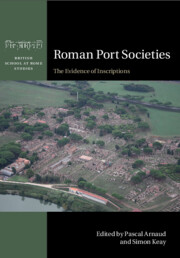Book contents
- Roman Port Societies
- British School at Rome Studies
- Roman Port Societies
- Copyright page
- Contents
- Figures
- Tables
- Contributors
- Abbreviations
- 1 The Context of Roman Mediterranean Port Societies
- 2 Inscriptions and Port Societies
- 3 Stationes and Associations of Merchants at Puteoli and Delos
- 4 Boatmen and their Corpora in the Great Ports of the Roman West (Second to Third Centuries AD)
- 5 Roman Port Societies and Their Collegia
- 6 Port Occupations and Social Hierarchies
- 7 Warehouse Societies
- 8 The Imperial Cult and the Sacred Bonds of Roman Overseas Commerce
- 9 Law and Life in Roman Harbours
- 10 Living Like a Cosmopolitan?
- 11 Ports, Trade and Supply Routes in Western Europe
- 12 The Port Society of Narona
- 13 Municipal Authority, Central Authority and Euergetists at Work at the Port
- 14 The Structure of Mercantile Communities in the Roman World
- 15 Polysemy, Epigraphic Habit and Social Legibility of Maritime Shippers
- 16 Reading Roman Port Societies
- Indexes
- References
15 - Polysemy, Epigraphic Habit and Social Legibility ofMaritime Shippers
Navicularii, Naukleroi, Naucleri, Nauculari,Nauclari
Published online by Cambridge University Press: 30 October 2020
- Roman Port Societies
- British School at Rome Studies
- Roman Port Societies
- Copyright page
- Contents
- Figures
- Tables
- Contributors
- Abbreviations
- 1 The Context of Roman Mediterranean Port Societies
- 2 Inscriptions and Port Societies
- 3 Stationes and Associations of Merchants at Puteoli and Delos
- 4 Boatmen and their Corpora in the Great Ports of the Roman West (Second to Third Centuries AD)
- 5 Roman Port Societies and Their Collegia
- 6 Port Occupations and Social Hierarchies
- 7 Warehouse Societies
- 8 The Imperial Cult and the Sacred Bonds of Roman Overseas Commerce
- 9 Law and Life in Roman Harbours
- 10 Living Like a Cosmopolitan?
- 11 Ports, Trade and Supply Routes in Western Europe
- 12 The Port Society of Narona
- 13 Municipal Authority, Central Authority and Euergetists at Work at the Port
- 14 The Structure of Mercantile Communities in the Roman World
- 15 Polysemy, Epigraphic Habit and Social Legibility of Maritime Shippers
- 16 Reading Roman Port Societies
- Indexes
- References
Summary
The Latin words navicularii and nauclari and the Greek ναύκληροι or naucleri provide us with aninteresting case study of epigraphic evidence. It isvery illustrative of the opportunities that thisevidence offers, as well as its limits of inference,and the amount of work still necessary for a soundunderstanding of its meaning. The corpus of knowntexts raises several issues. The first one is thesmall number of epigraphic occurrences of thesewords. Almost 90 individuals and more than 60mentions of groups may be considered to be asignificant corpus (Table 5). It is quite a smallnumber, however, if compared to the some 600inscriptions mentioning negotiantes, negotiatores and πραγματευόμενοι, or the45 inscriptions mentioning naukleroi on the island of Delos alonein the pre-Imperial period. Occurrences of maritimeshippers remain suprisingly rare given the largenumber of ports in the Empire and the time span ofc. 500 years underconsideration. Notwithstanding the presence of anumber of major coastal ports, the epigraphy of theRoman Near East has provided a very large number ofcitations relating to occupations, but has onlyproduced two naukleroi, one at Askalon, the other atAradus in a late inscription, although threeLevantine naukleroiare recorded in other geographical areas and ports.The reasons for such an epigraphic silence are worthexploring.
- Type
- Chapter
- Information
- Roman Port SocietiesThe Evidence of Inscriptions, pp. 367 - 424Publisher: Cambridge University PressPrint publication year: 2020



